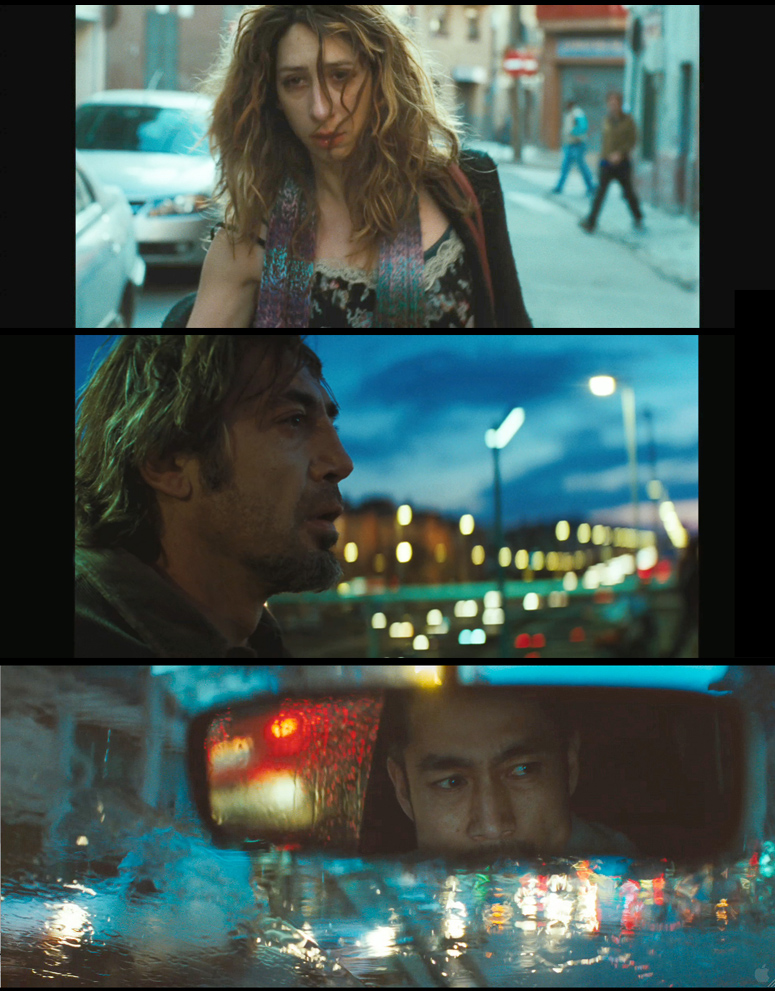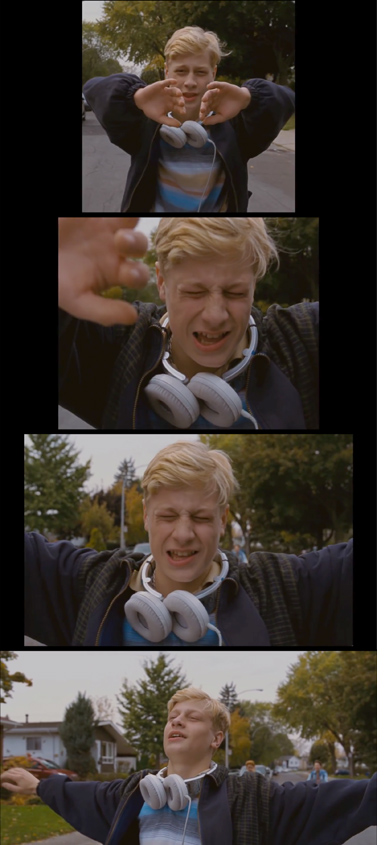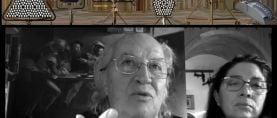
The Elastic Frame
This is a post about the transition in contemporary cinema to the elastic frame, a result of digital projection.

I first coined the expression "the elastic frame" in a 2014 post to describe a new, playful approach to aspect ratios by contemporary filmmakers. Some friends encouraged me to publish a post on the subject.
This is a post about the transition in contemporary cinema to the elastic frame, a result of digital projection.

1. Film-Projector Gates
2. Digital Projection
3. Biutiful (2010)
4. Anamorphic is not 2.40
5. Mommy (2014)
6. The Elastic Frame
7. Tradition and Innovation
Addendum: Eleven 35mm and 70mm Aspect Ratios
LINKS
+++
1. Film-Projector Gates
In the days of film projection, aspect ratios were defined by pieces of metal. In film cameras the gate is the window that lets light through to the negative. Gates have a slot for sliding hard mattes, thin pieces of metal that narrow the window to a desired aspect ratio. (Hard mattes were more frequent in European cinema than Hollywood, where producers demanded open gates to have the option to do minor reframing). Many (but not all) film prints were also exposed with metal mattes that blocked light, putting black around the intended image frame.
Film projectors were outfitted with metal gates that matched the aspect ratio of the film, though these gates were often slightly bigger than the target aspect ratio; for example, some theaters used 1.66 gates for 1.85 films so as to be sure to not impinge on the image.
In traditional 35mm, aspect ratios could be changed by optical printing, but it was a complicated process. Note also that prints of anamorphic films had squeezed images, and required changing the projector lens as well as the gate so as to unsqueeze the image optically during the screening.
+++
2. Digital Projection
There are no metal gates or plates in digital projectors. The projector has a 1.78:1 luminescent area, and the aspect ratio is simply defined by black cropping inside the image. This means that, in theory, the aspect ratio can be changed at any time during the screening, and to any dimensions. The frame has become elastic.
Anamorphic is also treated differently in film and digital projection. At present, digital projectors do not use anamorphic lenses: the digital image in the DCP is already unsqueezed. Some filmmakers point out that this means that digital anamorphic has less resolution than spherical because the 2.40 image is cropped on the 1.78 projector chip. By contrast, anamorphic film prints use more film area than spherical ones. Indeed the larger negative area was one of the advantages of 35mm anamorpic over spherical.
+++
3. Biutiful (2010)
Biutiful is a 2010 masterpiece by Alejandro Gonzalez Iñárritu, with stunning cinematograpy by Rodrigo Prieto, ASC, AMC. The film recounts three periods in the last weeks of a man with terminal cancer. Rodrigo distinguished these three periods by varying the lenses and aspect ratio: 1.85 with spherical lenses, 1.85 with anamorphic lenses, and 2.40 with anamorphic lenses. The spherical 1.85 depicts the hero's everyday life; the anamorphic 1.85 marks a troubled period of soul-searching; and the anamorphic 2.40 frames the film's catharsis, introduced by a dramatic scene that fills the entire screen: the bodies of migrants washing up on a beach in Spain.
+++

Biutiful by Alejandro Iñárritu
with cinematography by Rodrigo Prieto
- spherical 1.85
- anamorphic 1.85
(note the oval bokehs)
- anamorphic 2.40
+++
4. Anamorphic is not 2.40
Biutiful offers an innovative mixture of existing formats, combining the two dominant feature-film aspect ratios of 1.85 and 2.40. It would be impossible to show Biutiful in traditional film projection because you would have to change projections lenses from spherical to anamorphic during the screening.
Biutiful's use of anamorphic lenses in a 1.85 frame is unfamiliar and unsettling because it violates the traditional pairing of anamorphic and 2.40. But in digital cinema, anamorphic is no longer essentially linked to 2.40. Historically, this aspect ratio came to be in order to squeeze as much image as possible in the negative area available on a 4-perf piece of film.
Rodrigo's inventive use of anamorphic in Biutiful reveals an important transition in the cinema frame. With digital projection, anamorphic is separated from its traditional aspect ratio, which was defined by a previous technology. Anamorphic is an optical process, and 2.40 is a framing convention. And this in turn raises the question of the aspect ratio itself. What shape should the frame have when there is no technical reason to have one frame rather than another?
+++
5. Mommy (2014)
Mommy is a masterful 2014 film by the brilliant Xavier Dolan, with cinematography by André Turpin. At André's suggestion, Dolan shot most of the film in an unusual 1:1 aspect ratio. This square aspect is well suited to portraiture, in keeping with the film's emphasis on its three principal characters: the troubled teenager Steve, his mother, and his friendly tutor.
Dolan also uses the 1:1 to present his hero as boxed in. There are two decisive moments in the film when the frame opens up to a wide screen. In one of them, Steve is skateboarding to the tune of "Wonderwall" in a rare moment of carefree joy. Steve rides towards camera and spreads his arms to widen the screen out. The wide screen continues through a happy montage, but the image then shrinks back down to 1:1 when his mother discovers that Kevin is being sued because of aggressive behavior in school, and Steve's troubles re-emerge.
+++

Mommy
by Xavier Dolan
with cinematography by André Turpin
Steve widens the frame
during the "Wonderwall" montage
+++
6. Elastic Frame
Mommy's playful innovation earned Dolan the Jury Prize at the 2014 Cannes Film Festival, an award he shared with another pioneer, Jean-Luc Godard. Dolan shows us that in the age of digital projection, the aspect ratio is another aesthetic decision, and that filmmakers are not obliged to use traditional screen shapes. Moreover, Dolan also demonstrates that the aspect ratio can be dynamic, and evolve during a shot, or a movie. Today's filmmakers can and do use different aspect ratios, change aspect ratios during a scene, and define new frame shapes …. The cinema frame is now truly elastic.
+++
7. Tradition and Innovation
While it's true that digital projection allows filmmakers to shoot in any aspect ratio they choose, I must add two important provisos.
First, the shape of the camera sensor and projection DLP chip matter. It makes a lot of sense, for example, to shoot 2.39 with Alexa's 4:3 camera, because the 1.18 (half of 2.39) squeezed image is a good fit for the camera's 1.33 sensor. Likewise, filmmakers should be hesitant about using a small portion of a digital projector's 1.78 image, because this will lead to poor quality.
Second, and more important, cinema is about tradition and innovation. The dominant 1.85 and 2.40 aspect ratios are indeed just conventions, but they are not arbitrary shapes; hundreds of filmmakers have shown that they are powerful canvases for composition and storytelling. Future filmmakers will compose with elastic frames that include 1.85, 2.40, the aspect ratios listed below, and other surprising variations. Like all art forms, cinema is a potent mixture of tradition and innovation.
+++
ADDENDUM:
ELEVEN 35MM AND 70MM ASPECT RATIOS
+++
Eight 35mm Aspect Ratios
The history of cinema is marked by different frame shapes, as defined by aspect ratios of screen width to height.
1.33
The aspect ratio of silent films was set at 4:3, or 1.33:1. This aspect ratio was defined in part by the 4 perforations assigned to each frame. When television was standardized in the 1940s, its aspect ratio of 1.33:1 was chosen to match that of film.
1.37
When sound was introduced, the frame was slightly reduced to 1.37:1 (a.k.a. Academy) to make room for a sound track alongside the image.
As television developed in the 1950s, the studios made many attempts to create their own distinctive cinematic formats with bigger, wider screens to bring audiences back into the theaters.
1.66
In 1953, Paramount cropped the top and bottom of the 35mm 1.37 image to create a wider 1.66:1 image. Some European filmmakers continued to shoot in 1.66 for many years.
1.78
At the turn of this century, engineers chose 16:9, or 1.78:1, as the new video standard partly because it was a geometric mean between 1.33 and 2.35. 16:9 is also an exact multiple of the old 4:3 TV format.
1.85
In 1954, Paramount created the 8-perf VistaVision format, which turned the 35mm image on its side to create a 1.85:1 aspect ratio.
The width of VistaVision is the same as that of 35mm still film, and it offered a noticeable reduction in grain. Some 75 Paramount features were shot in VistaVision in seven years, until finer-grain film appeared. The format continued to be used for for special-effects sequences and some features.
While 8-perf VistaVision has all but disappeared today, 1.85 lives on as one of the two dominant formats (along with 2.40) in theatrical distribution today.
2.35 Anamorphic
In 1953, 20th Century Fox released The Robe, shot in anamorphic Cinemascope, with a 2.35:1 aspect ratio, created with a twofold optical squeeze in the camera lens and an expansion in the projector lens. Cinemascope lenses were soon replaced by Panavision lenses. This was the beginning the revolutionary widescreen anamorphic format that continues today with lenses from Angénieux, Cooke, Panavision, Vantage and Zeiss, among others.
2.39 (a.k.a. 2.40) Anamorphic
The 2.35:1 aspect ratio was slightly narrowed to 2.39:1 in the 1970s in order to accommodate wider film splices. However, some anamorphic features continue shooting in 2.35 to this day.
2.59 Cinerama
In the 1950s, Cinerama demonstrated a three-projector system to fill a giant, curved screen with a 2.59:1 image.
+++
Three 70mm Aspect Ratios
1.44 Imax 15-Perf
Imax is a 15-perf 70mm format that was launched in the 1970s in specialty venues. After exploring some lower-quality digital versions, Imax also released a dual 4K digital projection system in 2015.
Hollywood filmmakers started releasing tentpole movies in Imax at the beginning of this century. Director Christopher Nolan is notable for having shot parts of his movies in Imax, including Batman Begins, The Dark Knight and Interstellar.
2.2 5-Perf
In 1955, Oklahoma! was shot in 5-perf 65mm format, with a release in 70mm with a 2.2:1 aspect ratio. Some 50 features have been shot in spherical 65mm to date, the most recent being Paul Thomas Anderson's The Master in 2011.
2.76 Ultra Panavision 70 Anamorphic
This format was inaugurated in 1959, using anamorphic lenses with a 1.25 squeeze to achieve 2.76:1, the widest aspect ratio to date. This format was revived recently by Robert Richardson, ASC, to shoot The Hateful Eight in 2015.
+++
LINKS
thefilmbook: Cannes 2014: Freeform Filmmaking
American Cinematographer: my article on Biutiful
wikipedia: Biutiful
thefilmbook: Mommy: Interview with Xavier Dolan
thefilmbook: Mommy: Interview with André Turpin
YouTube: Mommy - Wonderwall scene
theguardian.com: Xavier Dolan triumphs in row with Netflix UK over his film's aspect ratio
filmmakeriq.com: The changing shape of cinema - the history of aspect ratio
wikipedia.org: List of VistaVision films
wikipedia.org: VistaVision
wikipedia.org: List of 70mm films
YouTube: TODD AO vs CINEMASCOPE
YouTube: The Cinemascope story
thefilmbook: Large Format: Ultra Panavision 70
slashfilm.com: ‘Guardians of the Galaxy’ IMAX 3D Shows Will Feature Shifting Aspect Ratios
+++
THEFILMBOOK - PRACTICAL OPTICS
Practical Optics 1 - Testing Different Sensor Sizes
Practical Optics 2 - Notes on Lenses & Elastic Formats
Practical Optics 3 - Introduction to Anamorphic
Practical Optics 4 - Anamorphic Video Examples
+++
Top illustration of all the formats copyright Benjamin B 2016
+++







